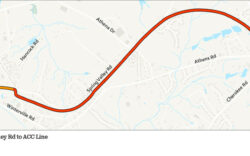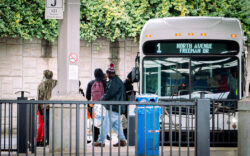Melissa Link
Age: 43
Occupation: managing editor, Ethics & the Environment, UGA Department of Philosophy
Party: Democrat
Address: 148 Hiawassee Ave.
Phone: 706-372-3382
Email: [email protected]
Website: melissalinkathens.com
Athens-Clarke County has one of the highest poverty rates in the nation. What should the local government be doing to alleviate poverty?
Our college-town, service-industry based economy and a proliferation of notoriously low-wage jobs at our region’s largest employer (UGA) have much to do with our shameful poverty rate. Approximately 50 percent of our residents are college-educated, and our unemployment rate is actually quite low. Too many educated workers are employed in mid-range service industry jobs, while those who have not had such educational opportunities are trapped in low-wage positions with little hope of moving up. We all know no one can make ends meet on minimum wage, thus many of these folks are working two or more jobs and often spend hours on the bus traveling between them—time during which they could be earning more money, helping their kids with homework, preparing quality meals for their families or furthering their education. Socioeconomic status and academic achievement directly correlate, and academic achievement opens up better employment opportunities. Our schools have made remarkable progress in recent years in spite of our poverty problem, but we cannot begin to achieve true success in our schools until we reduce poverty in our community.
ACC can do several things:
• ACC’s Economic Development Department can focus on luring higher-paying tech, creative industry, medical, research and information jobs to employ our educated workforce and free up mid-level service industry positions to pull many out of the pit of minimum-wage employment and thus create more mid-level service positions as higher-paid educated workers will spend more.
• Invest in our transportation system to assure affordable, accessible and convenient public transit and safe, accessible, interconnected bike and pedestrian routes from residential communities through commercial corridors into downtown.
• Assure affordable and diverse in-town neighborhoods so that our lower-income residents aren’t forced to live on the outskirts of town far away from jobs, services and their traditional communities. This can be approached with a new look at property taxes, residential zoning guidelines, and historic districts.
• Increase funding for our Leisure Services Department programming and partner with UGA to increase affordable after-school and summer camp activities to assure better access to child care for low-income families and to provide their children with creative, fun and safe out-of-school educational experiences.
• Divert a portion of the EDD’s $500,00 budget to a small business development program to encourage and support local entrepreneurship, especially in our minority community, to encourage diversity within our local business culture and to guide these businesses toward greater success.
Downtown development has been a major issue the past few years. Is this a good trend for Athens, and if not, how can we curb it and/or encourage development other than student apartments?
Our downtown cultural center is key to our overall identity and is vital to luring tourists, new residents and businesses alike. As a leader of People for a Better Athens, I worked tirelessly to keep Walmart out of downtown and continued to oppose Selig’s now-defunct massive student housing/parking deck project. Even after the project gained mayor and commission approval, I uncovered improprieties in the process and forwarded them to the proper channels. Yet another plan for this property has been presented and, while it is preferable in many ways to Selig’s, it is still thoroughly student-oriented and fails to include a feasible interpretation of the connective transportation corridors mandated by our adopted official future transportation plan—thus abandoning a functional interconnection between a possible future River District and Brain Train/light rail station and additional Classic Center expansion to UGA, Highway 78, the Loop and three federally-funded alternative transportation projects (the Multimodal Transportation Center, the rail-trail and the park-and-ride lot).
Whatever the future possibilities for a River District in Athens may be, the Armstrong & Dobbs property is a critical gateway to this area. If our cultural/business center is to grow sustainably, we must implement a functional, sustainable, multimodal transportation infrastructure to accommodate a prosperous future. This eastern edge of downtown figures prominently in the vision put forth by the Downtown Master Plan, and its successful development hinges on our ability to efficiently move people in cars, buses, bikes, foot,and hopefully trains into and out of it. I am terribly worried about the homogenization of our beloved downtown brought about by massive exclusive student influx and corporate gentrification. In light of some of the pressures many of our traditionally lower-income in-town neighborhoods are seeing due to increasing gentrification in Athens’ booming in-town housing market, I would like to encourage much greater diversity in our downtown business development to include a greater variety of locally owned businesses and office space to lure desirable industry, but also middle class residential townhomes and penthouse flats—a diverse environment to serve the entire region and also provide homes for retirees, young families, young professionals, UGA staff and faculty, as well as a few students in the mix.
Do you support expanding Athens Transit service, reducing fares and/or exploring a merger with the UGA bus system? If so, how would you pay for it?
An affordable, accessible and sustainable multimodal transportation system is one of the most important investments we can make to address widespread economic inequality, rapid cultural change, public health crises and the inevitable reality of a future in which dependence on fossil fuels will no longer be possible. Studies prove that fare increases are the least effective means of increasing revenues for public transit systems. I’ve been a regular rider of both Athens Transit and the UGA bus system for most of my 20 years in Athens, and it is clear that our system is no longer working effectively. In these 20 years, our population has doubled and our demographics have flipped, yet the general route layout of our public transit system has remained essentially the same. We can look to similar cities such as Chattanooga, TN, Clemson, SC and Chapel Hill, NC, for inspiration on how to reduce or eliminate fares, lure new riders, reduce costs and increase frequency. While often these systems are paid for by parking fees and transportation sales taxes—options that are not very feasible in our community, I do believe that, at the very least ,ACC can lure new riders with hip marketing efforts and find a better way to interface with UGA’s system and possibly take over some of the routes served by UGA to pull in revenue from fare-paying customers. The popularity of the UGA Health Sciences Bus on Prince Avenue is proof that in-town residents will eagerly opt for public transit when offered frequent, convenient and affordable service. I believe Athens Transit should emulate this route on several in-town commercial corridors, utilizing smaller, cheaper, quieter and environmentally friendly electric buses with reduced fares. Considering the increased suburbanization of impoverished communities, it’s high time we implemented interconnecting, outside-the-loop routes to make for a more efficient system to serve those who need it most.
Athens is often pigeonholed as “business unfriendly.” Do you support easing restrictions on businesses? If so, which ones?
Locally owned small businesses are the building blocks of a healthy local economy and an important part of our cultural identity. While ACC’s new Economic Development Department is solely focused on luring and assisting industry and large developments, our local government offers absolutely no mechanism to encourage or guide small business owners. I support tax incentives for locally-owned businesses—after all, nearly 75 percent of the profits earned by locally owned businesses are recirculated in the local economy, compared to only 45 percent from those owned by corporations or out-of-towners. And I support easing some petty restrictions on our small businesses. First off, we need to encourage food trucks and cart vendors downtown and along our commercial corridors. If we are to live up to our “foodie destination” reputation, we must encourage a thriving food truck culture. These businesses traditionally require little start-up capital and minimal overhead and can offer an ideal launching pad for creative entrepreneurship. Currently, they are highly regulated to the point that they are expensive and burdensome to operate and their restriction from parking in public spaces or lots greatly reduces their ability to reach customers. We also need to take a good look at some of our hyper-restrictive regulation of signage and other stringencies placed on small businesses. ACC is happy to grant all manner of variances, special use permits and tax abatements to large developments in the name of better business, and these large businesses can readily afford the qualified lawyers and architects to find the loopholes to work the system, yet we frequently punish our treasured and often struggling locally owned businesses for seemingly petty infractions that often result from a simple lack of awareness of the details of our own local bureaucracy.
Are you in favor of the Complete Streets: Prince Avenue lane reconfiguration demonstration project? Why or why not?
Of course. I live a block off Prince Avenue and cross it to catch the bus and walk along it every day. And every day from inside my home I hear the screech of tires (occasionally followed by a crash) as speeding cars come to a sudden halt for stoplights, cars, bikes and pedestrians. I’ve been speaking out alongside my neighbors for over a decade for something to be done to calm the traffic and encourage appropriate development along Prince. I offered input along every step of the Prince Avenue Corridor Study, and I am flabbergasted that so much citizen outcry and community capital is being essentially ignored. The fact that citizens have had to take it upon themselves to come up with a plausible plan toward implementing improvements despite the existence of a publicly funded study that recommends them is a sad statement on the blind eyes, deaf ears and obstructionism that abounds in our local government as of late. The demonstration project is a no-brainer in my eyes—a meager first step toward protecting the safety of our citizens along this most visible corridor through our most politically active neighborhoods. If we cannot make progress along Prince, we have no hope of ever improving the safety, economy and the lives of those living along some of our truly dangerous and long-neglected corridors, including West Broad Street, Oconee Street and North Avenue. Improving these corridors to assure safe accessibility for pedestrians and cyclists as well as cars is not just an issue of convenience and environmental quality, but is a matter of economic justice to serve the thousands of our citizens who live, work and travel along these corridors daily but cannot afford a car—and it is a means of preparing for a future in which reliance on cars will be increasingly difficult.
What other issues concern you?
Protecting our neighborhoods is a huge concern. I’ve been a member of the Boulevard Neighborhood Association steering committee for nearly a decade, serving as its Environment/Preservation Chair for several years. I’m a proud neighborhood activist, and I regularly address not only the mayor and commission, but the planning commission, the historic preservation commission, the downtown development authority and the hearings board on issues regarding development, sustainable transportation and historic preservation as they pertain to maintaining affordable housing and diversity in our in-town neighborhoods. District 3 includes five historic districts, and I am intimately aware of the intricacies and the need for tweaking of our historic preservation approval process. None of my opponents can claim this level of involvement in neighborhood protection, and Mr. Gilmore’s record on the planning commission is particularly troubling, as he once voted in favor of a Prince Avenue project that demolished an affordable and architecturally historic housing community and would have allowed for a office tower and parking deck to be constructed to loom seven stories over an enclave of modest mill cottages in the Boulevard Historic District. Such large-scale commercial encroachment into neighborhoods is unacceptable. Increasingly, high-end redevelopment and student encroachment has rendered many of our in-town neighborhoods unaffordable for regular middle-class folks. More and more professionals are moving into traditionally lower-income neighborhoods while our lower-income citizens, including our artists and musicians, are becoming dispersed in the outskirts of town. These folks are not just far away from jobs and services, but they are taken away from their traditional communities and the support networks that can help ease the burdens of poverty. Athens’ famed creative culture grew out of the collaborative spirit that thrived in our diverse, affordable in-town neighborhoods and manifested itself in a quaint and funky downtown that is becoming increasingly homogenized and high-priced. This creative culture put us on the map, it is our golden egg and if we allow this gentrification and redevelopment to continue unchecked, we will strangle that goose.
Like what you just read? Support Flagpole by making a donation today. Every dollar you give helps fund our ongoing mission to provide Athens with quality, independent journalism.









